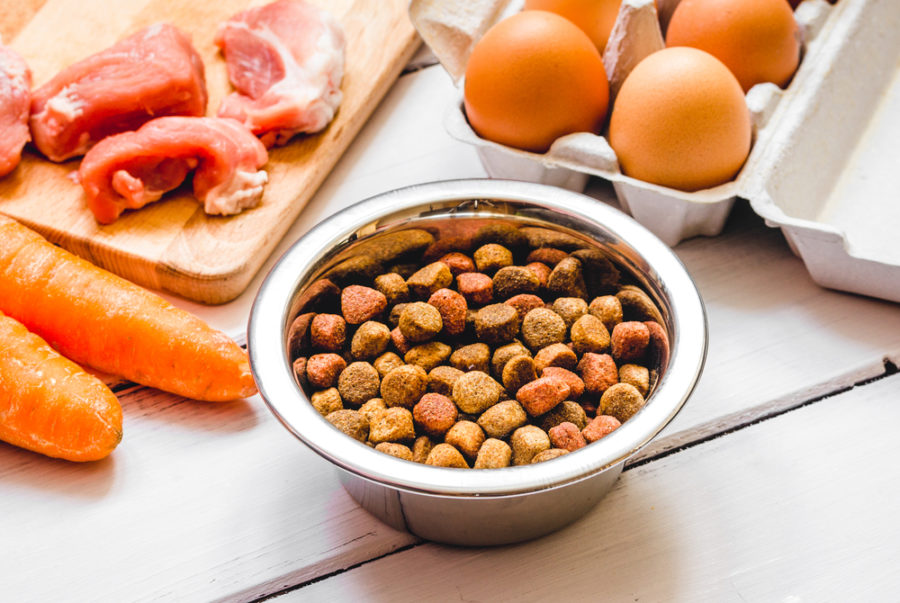Have you considered adding a kibble topper to your pet’s regular meals? Here’s why you should!
At first glance, kibble toppers might seem like a needless trend – another way for pet parents to spoil their precious fur babes. But the truth is, kibble toppers make a healthful addition to cats and dogs regular meals. They’re an easy, cost-effective way to improve the nutritional value of food, and provide the essential hydration that kibble cannot. The fact that animals love them is just a bonus!
What are kibble toppers?
Anything that “tops” your animal’s kibble can be considered a kibble topper! Pre-formulated varieties sold in pet stores are sometimes marketed as “meal mixers”, and typically contain dehydrated or freeze-dried meats and organs, probiotics and/or superfood blends. Store-bought kibble toppers are extremely convenient, and are carefully formulated to add moisture content, increase protein, or add vitamins and minerals to pet food.
That said, certain higher-quality kibble topper brands can be pricey, making them inaccessible to some pet parents. That’s why it’s important to remember that kibble toppers come in all shapes and sizes. There is no “traditional” kibble topper,” says Lindsay Tracy, Director of Product Development at Redbarn Pet Products. “Kibble toppers could be your dog’s favorite treat sprinkled on top to entice them to eat their dry food; it could be a spoonful of wet food to help your cat stay hydrated; or, it could be safe and healthy ‘pet friendly’ people foods randomly pulled from the fridge.”
Expert Tip: Toppers are great for cats. In fact, kibble toppers offering a boost of hydration to cats during mealtime may be one of the most beneficial uses of kibble toppers.
Keeping the cost down
Many pet parents are put off by the idea of kibble toppers because they assume it’s not a budget-friendly “extra”. But there are many ways to keep kibble toppers cost-effective.
First of all, consider the size and needs of your pet. If he’s a Great Dane that isn’t getting enough moisture in his diet, a high-end meal mixer might not be the more affordable option. “All-natural, low-sodium chicken or beef broth is a popular low-cost option that can help dogs and cats stay hydrated throughout the day,” Lindsay suggests.
The second thing to think about is how often you plan to use kibble toppers. If you want to top his food once or twice a week as a special treat, you can probably afford a packaged brand. But if your pet is picky and requires a tasty addition to every meal, something in your pantry, like a piece of chicken or a few drops of olive oil, might be enough to entice him. “Inexpensive, pet-friendly people food from the kitchen can offer pets an array of nutritional benefits not found in their day-to-day food while expanding the flavor profile,” says Lindsay.
Expert Tip: “Add frozen vegetables, like green beans, which aids in transitioning a dog into eating less kibble as a healthy weight management tool,” says Lindsay.
Top reasons to use kibble toppers
Still not convinced that kibble toppers are right for your pet? You might be right. But chances are, if all you feed is kibble, you pet is lacking something in his diet. It might be a certain nutrient, it might be moisture, or it might just be a little variety! “There are two main reasons to consider adding kibble toppers to your pet’s food, regardless of whether you currently feed him wet or dry food,” says Lindsay. “The first is simply to add more variety and flavors without causing digestive upset. Three types of kibble toppers can help with this issue: low-calorie treats, wet food, and people food.
Expert Tip: Adding low-calorie treats, like REDBARN’S ONE-CALORIE PROTEIN PUFFS for cats or dogs, on top of wet or dry food can entice your pet to finish that meal they’ve been avoiding. A scoop of wet or raw food atop dry food can also add some appeal.
“The second reason to use a kibble topper is to ensure your pet receives hard-to-get nutrients or nutrients otherwise missing from their daily food due to health conditions,” Lindsay adds. “A veterinarian would be a pet parent’s best resource for help selecting the most beneficial food topper.”
Additional kibble topper tips
Whether you decide to buy your pet a kibble topper or get creative with ingredients you already own, there are a few things to keep in mind:
- Never add anything to your pet’s diet without checking to make sure it’s safe! Some human foods, like onions and raisins, are toxic to dogs and cats, so stay clear of those. If you’re not sure, ask your vet.
- “Toppers should be a low-calorie food,” says Lindsay. “It’s a great idea to add toppers so your pet doesn’t have to eat the same food every day, but not at the cost of their weight and overall health.”
- Introduce the kibble topper slowly to prevent digestive upset. Like us, dogs and cats can get sick from eating too much of something they’ve never tried before.
- “When buying food toppers from a manufacturer, make sure the treat or topper has a short and clean ingredient list, uses all-natural ingredients, and is safely cooked to retain essential nutrients,” says Lindsay.








